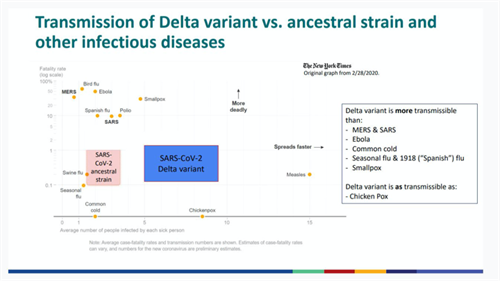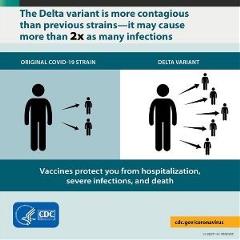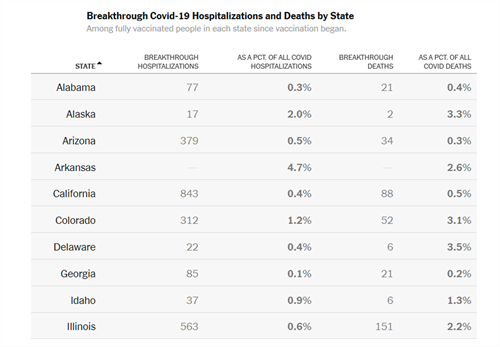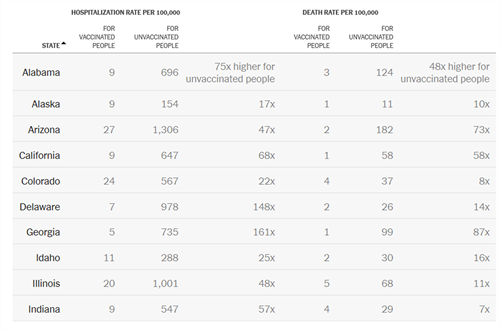Dear Patients of Sansum Clinic,
I think we all hoped that I would not be writing about COVID-19 this far into 2021. But, unfortunately, there is a lot going on and there are things worth discussing.
You all know the big picture of what is happening: there has been a very significant and alarming uptick in cases, particularly in areas of relatively low vaccination, all fueled by the ascendancy of the Delta variant of the virus that causes COVID-19 (SARS-CoV-2).
With that background, with which you are likely familiar already, I thought we’d talk about the biology of the Delta variant compared to the “original” version of virus, the current and changing situation with vaccinations, and some new directives from the California Department of Public Health for healthcare providers.
The Delta Variant
Viruses mutate all the time. With every infection there are millions of episodes of the genetic code (RNA in this case) being copied and replicated by the virus. From an evolutionary standpoint that is the whole point of the virus infecting its host – to create more copies of itself to then infect others. With those millions of occurrences of copying the genetic code, there are errors. Most of the time the errors are irrelevant, causing no significant change in the nature of the virus. Some might even be detrimental to the virus. Those mutations that weaken the virus are not preserved as that new variant might be less effective than others at infecting people and it will not get traction in the race to infect hosts. Sometimes, however, the mutation confers an advantage to the newly created variant. It might be more effective at getting into its host than its “parent” was. Such a variant, that is just better at attaching to and entering human cells, then has an advantage over other variants and becomes the predominant strain. That is what happened with the Delta variant, which is now the dominant strain in Santa Barbara, the whole state of California and the US and many other countries.
Below is a slide created by a colleague who is an infectious disease specialist. On the Y-axis is the case fatality rate. On the X-axis is the number of people each infected person typically infects. Note that the Y-axis is in log-scale, meaning that something twice as high on the graph may in fact be 10 times higher in terms of the value being measured, in this case lethality. Several common and exotic respiratory viral illnesses are listed in comparison to the “ancestral” (original) SARS-CoV-2 virus and the Delta variant.

The important take home points from this graph are the Delta variant may be more pathogenic (deadly for an individual) than the ancestral variant, as there is some evidence to suggest that. However, the real problem with the Delta variant is that it is much more infectious than its ancestor. It went from being as infectious as a common cold or flu to as infectious as chickenpox. Mathematically, the ancestral strain when it infected someone resulted in about 2 other people getting infected. The Delta strain when it infects someone typically results in about 5 others getting infected. (The CDC has a simple graphic on its website using these numbers, below.) Measles is about the only common respiratory viral infection more contagious than the Delta variant. It is the ascendancy of this much more infectious variant that is the problem right now.

Role of Vaccines in the Current Phase of the Pandemic
As noted in the CDC graphic (above) vaccines are very effective at preventing those vaccinated from severe infections, hospitalization and death from COVID-19. Because the Delta variant is so effective at entering human cells, there are breakthrough infections even in vaccinated people. In fact, about 20% of infections in Santa Barbara are “breakthrough” infections, occurring in vaccinated people. However, vaccinations are very effective at preventing the most dreaded outcomes of COVID-19 infections, specifically hospitalization and death.
Below is data reported in the New York Times, analyzing the percentages of people with breakthrough infections who are hospitalized or die with COVID-19 compared to all people with those outcomes who have COVID-19. Taking California as an example, of the people hospitalized with COVID-19, only 0.4% of those were vaccinated, meaning 99.6 were not vaccinated. For death from COVID-19, in California, at the time of this data, 99.5% of people dying with COVID-19 were not vaccinated. The states vary slightly, but the story is the same.

NYT, August 11, 2021
If we look at this differently, in terms of the rate of those same outcomes – hospitalization and death from COVID-19 – and then compare the rate of those outcomes between vaccinated and unvaccinated, the data looks like this:

NYT, August 11, 2021
In California, the rate of hospitalization for COVID-19 is 68 times greater for unvaccinated people than vaccinated people. The rate of death from COVID-19 is 58 times higher for unvaccinated people compared to those who have been vaccinated. Again, the numbers vary by state, but the story is the same: the rate of hospitalization and death from COVID-19 is greatly reduced by vaccination.
I understand there are many reasons people have for not getting vaccinated. But, considering the change in the Delta variant’s infectiousness, this data is really compelling about the benefit of vaccination.
The Pfizer-BioNTech vaccine (what everyone calls the “Pfizer vaccine”) has just received final approval from the FDA. Most expect Moderna’s vaccine will shortly follow. Many of us hope that the removal of the Emergency Use Authorization status will encourage some more people to get vaccinated, though data suggests that is a minority of those reluctant to get vaccinated.
As an aside, I should remind you to get a flu shot. If you get the flu you will not know if you have COVID-19 or the flu. You will need to get tested or quarantine, or both, while it gets sorted out. Also, getting both the Flu and COVID-19 at the same time could be devastating.
Booster Doses
Recently, the federal regulatory agencies in charge of the vaccine supply have authorized 3rd doses (“booster doses”) of the mRNA vaccines (Pfizer and Moderna) for people who are moderately or severely immunocompromised, meaning that their immune systems are less likely to respond to the vaccines or, if they respond, are less likely to maintain a durable response. Work is still being done on the Johnson & Johnson vaccine to see if people who received that vaccine, which was intended as a single dose, will need an additional dose.
The CDC and FDA have defined the individuals who fall into the category of moderately or severely immunocompromised as follows.
People who have:
- Been receiving active cancer treatment for tumors or cancers of the blood
- Received an organ transplant and are taking medicine to suppress the immune system
- Received a stem cell transplant within the last 2 years or are taking medicine to suppress the immune system
- Moderate or severe primary immunodeficiency (such as DiGeorge syndrome, Wiskott-Aldrich syndrome)
- Advanced or untreated HIV infection
- Active treatment with high-dose corticosteroids ( i.e., >20 mg prednisone or equivalent per day), alkylating agents, antimetabolites, transplant related immunosuppressive drugs, cancer chemotherapeutic agents classified as severely immunosuppressive, tumor necrosis (TNF) blockers, and other biologic agents that are immunosuppressive or immunomodulatory.
Those are the people who currently meet the criteria to get a “booster dose”. We have begun to vaccinate our patients who have these conditions and have appointments with their doctor. We also will begin vaccinating those who meet these criteria by having their physician refer them to our “COVID Booster Clinic.” People who meet this criteria will be eligible 28 days after their 2nd dose of Moderna or Pfizer.
Please note that this is the criteria that we will be using for now. There are people with other chronic illnesses or infirmities who will be eligible for a booster dose on the basis of time from their 2nd dose (see below) even though they are not yet eligible now.
Regulators have begun to indicate that all people who received two doses of an mRNA vaccine will likely be eligible soon for a booster dose of the same vaccine (Pfizer or Moderna) that they previously received, starting 8 months after their second dose. Even though this aspect of booster doses has not yet been approved, we believe more people will become eligible starting in the middle of September. We think that will, initially, include healthcare workers and residents of nursing homes as those were the first groups eligible to receive vaccines on the first go-around of this process. The details of how all of those eligible to receive a booster dose will get one are still being worked out by the Public Health authorities. As it gets closer, we will provide more information.
Recent Changes in Public Health Guidelines for Healthcare Workers
The California Department of Public Health (CDHP) recently announced regulations that will require that all healthcare workers need to be vaccinated for COVID-19 by September 30, 2021. Within the last two weeks, healthcare workers who had not been vaccinated have had to undergo mandatory testing for COVID-19 either once or twice a week, depending on where they work.
As noted, the September 30 deadline will require healthcare workers to be vaccinated, unless they have a medical exemption or a religious exemption. At Sansum Clinic and our local hospitals, all healthcare workers and patients are required to wear masks, regardless of their vaccination status. We do not anticipate that will change for the foreseeable future (though we all look forward to the time when we can safely remove them). Masks, when worn correctly, are very effective at greatly reducing transmission of virtually all respiratory illnesses, including COVID-19.
Conclusions:
- The current spike in disease activity is due to the emergence of the much more infectious Delta variant.
- Vaccinations are extremely effective at preventing someone from winding up in the hospital with COVID-19 or dying as a result of that illness. They are effective at preventing any form of COVID-19 infection, but in preventing the really bad outcomes, these vaccines are remarkably effective.
- Booster doses are now available for those with moderately or severely impaired immune systems. (Again, see the definition above.)
- Most people don’t meet the current definition of who is eligible now. We anticipate that all of the regulatory agencies will approve a third (booster) dose of Pfizer or Moderna to be given 8 months after that second dose of the original series. We are waiting to hear about Johnson & Johnson and additional doses. More to follow on this as details emerge.
- Get vaccinated for COVID-19 if you have not already, and get a flu shot when they are available!
Stay safe. And yes, we are still smiling under our masks.
Kurt Ransohoff, MD, FACP
CEO, Chief Medical Officer
Sansum Clinic